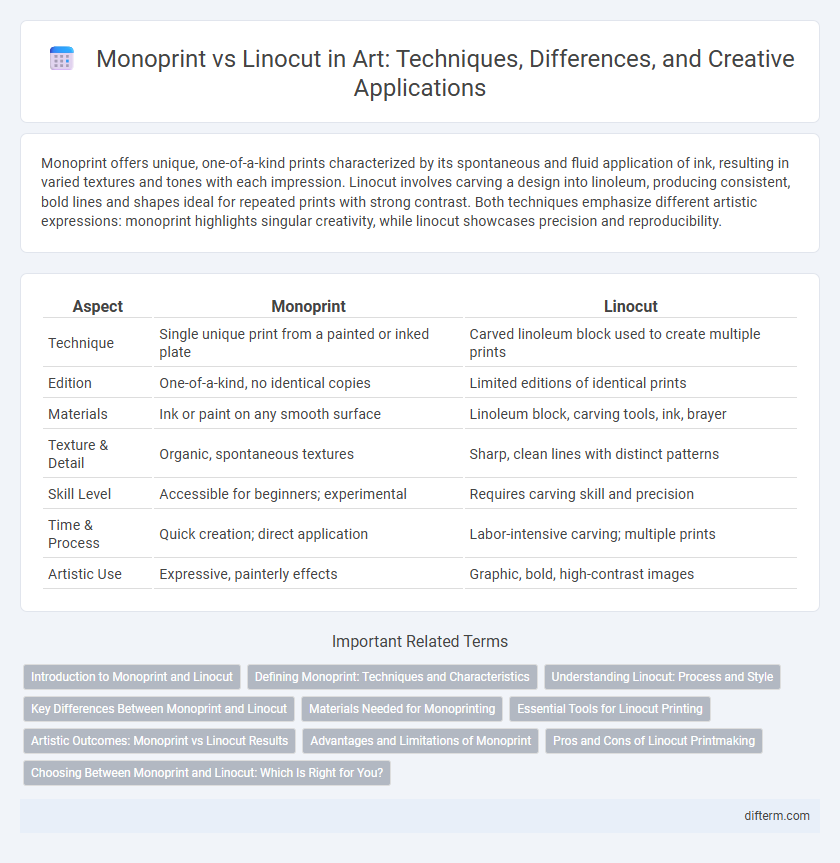Monoprint offers unique, one-of-a-kind prints characterized by its spontaneous and fluid application of ink, resulting in varied textures and tones with each impression. Linocut involves carving a design into linoleum, producing consistent, bold lines and shapes ideal for repeated prints with strong contrast. Both techniques emphasize different artistic expressions: monoprint highlights singular creativity, while linocut showcases precision and reproducibility.
Table of Comparison
| Aspect | Monoprint | Linocut |
|---|---|---|
| Technique | Single unique print from a painted or inked plate | Carved linoleum block used to create multiple prints |
| Edition | One-of-a-kind, no identical copies | Limited editions of identical prints |
| Materials | Ink or paint on any smooth surface | Linoleum block, carving tools, ink, brayer |
| Texture & Detail | Organic, spontaneous textures | Sharp, clean lines with distinct patterns |
| Skill Level | Accessible for beginners; experimental | Requires carving skill and precision |
| Time & Process | Quick creation; direct application | Labor-intensive carving; multiple prints |
| Artistic Use | Expressive, painterly effects | Graphic, bold, high-contrast images |
Introduction to Monoprint and Linocut
Monoprint is a unique printmaking technique that produces one-of-a-kind impressions by applying ink or paint on a smooth surface, then transferring the image onto paper, emphasizing spontaneity and texture variations. Linocut involves carving a design into a linoleum sheet, which is inked and pressed onto paper, creating bold, high-contrast prints with clean, sharp lines and repeated motifs. Both methods offer distinct artistic expressions, with monoprints highlighting singular creativity and linocuts emphasizing precision and reproducibility.
Defining Monoprint: Techniques and Characteristics
Monoprint is a unique printmaking technique characterized by its one-of-a-kind impressions created through painting or inking a smooth, non-absorbent surface before transferring the image onto paper. This process allows for spontaneous and expressive marks, often using tools like rollers, brushes, or fingers to manipulate textures and tones. Unlike linocut, monoprint does not rely on a carved matrix, resulting in singular prints with varied textures and rich, painterly qualities.
Understanding Linocut: Process and Style
Linocut is a relief printmaking technique where artists carve a design into a linoleum block, applying ink to the uncarved surface before pressing it onto paper. This method allows for bold, graphic lines and strong contrast, creating distinctive textures and shapes that define the linocut style. Compared to monoprint, linocut offers repeatability and precision, making it ideal for artists seeking consistent prints with sharp detail.
Key Differences Between Monoprint and Linocut
Monoprint produces unique, one-of-a-kind prints through a process of painting or inking a smooth surface and transferring the image onto paper, whereas linocut involves carving a design into a linoleum block, creating multiple consistent prints. The monoprint technique emphasizes spontaneity and texture variation, while linocut offers precise, repetitive patterns with clear, bold lines. Artists often choose monoprint for experimental, singular artworks and linocut for graphic, repeatable compositions.
Materials Needed for Monoprinting
Monoprinting primarily requires a smooth, non-absorbent plate such as plexiglass or metal, along with oil-based or water-based inks that can be easily manipulated for unique prints. Essential tools include brayers for inking, various brushes, and paper suitable for transferring the ink, often rice or printmaking paper. Unlike linocut, monoprint materials emphasize flexibility and spontaneity to create one-of-a-kind impressions.
Essential Tools for Linocut Printing
Linocut printing requires essential tools such as a linoleum block, carving gouges in various sizes, a brayer for ink application, and a smooth surface for printing. High-quality carving tools with sharp blades ensure precise cuts and detailed designs, while a soft rubber brayer evenly distributes ink across the linoleum surface. Using a printing press or baren helps achieve consistent pressure for clean, crisp prints in linocut artwork.
Artistic Outcomes: Monoprint vs Linocut Results
Monoprint delivers unique, one-of-a-kind prints characterized by spontaneous textures and fluid, unpredictable lines that emphasize artistic expression and experimentation. Linocut results yield bold, graphic images with clear, sharp edges and repetitive patterns, highlighting precision and control in design. The choice between monoprint and linocut significantly impacts the final artwork's visual texture, detail, and overall mood.
Advantages and Limitations of Monoprint
Monoprint offers unique artistic advantages such as producing one-of-a-kind prints with spontaneous textures and effects that are difficult to replicate in linocut. Its limitations include less control over fine details and lower print run consistency compared to linocut's ability for precise, repeatable patterns. Artists favor monoprint for experimental expression and singular compositions, while linocut excels in creating multiple copies of detailed designs.
Pros and Cons of Linocut Printmaking
Linocut printmaking offers sharp, bold lines and strong contrast, ideal for graphic, high-impact images, and its material is easy to carve for beginners. However, linoleum can wear out quickly under heavy use, limiting the edition size and detail compared to other printmaking methods. The technique requires physical effort and precision, which can be challenging for intricate designs or extensive production.
Choosing Between Monoprint and Linocut: Which Is Right for You?
Monoprint offers unique, one-of-a-kind prints with expressive textures and spontaneous creativity, ideal for artists seeking experimentation. Linocut involves carving a linoleum block to create crisp, reproducible images, suited for those who prefer precision and multiple editions. Choosing between monoprint and linocut depends on whether you prioritize singular artistic expression or controlled repeatability in your prints.
monoprint vs linocut Infographic

 difterm.com
difterm.com